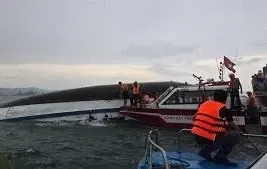What Caused the Tragic Capsizing of a Cruise Ship in Vietnam’s Ha Long Bay?

Synopsis
Key Takeaways
- 37 fatalities confirmed from the capsizing.
- Rescue operations are ongoing, with 11 survivors rescued.
- The incident was caused by a severe storm.
- The ship was carrying 48 tourists, primarily Vietnamese families.
- The government pledges a thorough investigation.
Hanoi, July 20 (NationPress) A devastating incident unfolded in northern Vietnam as a cruise ship, with numerous tourists onboard, capsized in Ha Long Bay, located in Quang Ninh province, due to an unexpected and fierce storm. Reports from the Vietnam News Agency indicate that the confirmed death toll has tragically climbed to 37, while search and rescue operations are still in progress.
The calamity took place on Saturday at around 1:30 p.m. local time when the vessel was caught in a severe storm that hit the area. By 2:05 p.m., the ship had lost all communication with authorities and subsequently sank into the bay's depths, officials stated.
At the time of the accident, the cruise was transporting 48 individuals, equally divided between 24 men and 24 women, with many being young adults and children.
According to the local news outlet Tien Phong, the majority of the passengers were Vietnamese families visiting the UNESCO World Heritage site from the capital, Hanoi.
Despite the difficult weather and torrential rain, rescue teams have successfully retrieved 11 individuals from the water alive. However, numerous others remain unaccounted for, leading to a large-scale search operation expected to continue throughout the night.
The Prime Minister, Pham Minh Chinh, expressed his deep condolences to the bereaved families and has called for a comprehensive investigation into the tragedy.
In an official statement, the government stressed that any infractions that contributed to the incident would be dealt with “stringently.”
Ha Long Bay, renowned for its stunning emerald waters and countless limestone islands, ranks among Vietnam’s premier tourist destinations. In 2019, it attracted over 4 million visitors, both domestically and internationally.
As the search for survivors persists, the nation grieves for those lost in one of its most cherished natural landmarks.








